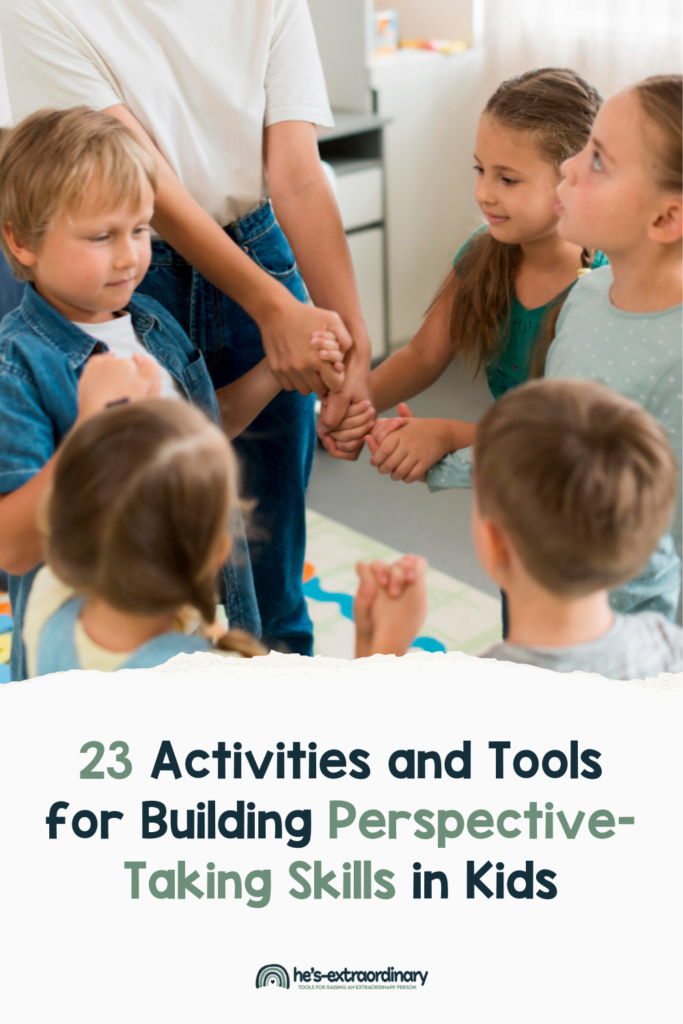Fun Activities and Tools for Building Perspective-Taking Skills in Kids
What’s inside this article: A list of fun perspective-taking activities and educational tools, like free printables, board games, apps, and art activities designed to help kids build this valuable social skill.
Disclaimer: This post contains affiliate links.
What is Perspective Taking
Perspective-taking is the ability to understand a situation or interpret information from another person’s point of view. It’s a skill that begins developing in early childhood and continues to grow into adolescence and beyond.
It’s an important part of kids’ social-emotional development, and building this skill helps children show empathy and compassion towards others.
Strong perspective-taking abilities lead to improved relationships and better problem-solving skills, too.
This article covers a variety of tools and activities designed to enhance perspective-taking skills in children.
Signs a Child is Struggling with Perspective-Taking:
Children with ADHD or autism often face more significant challenges in perspective-taking than their peers due to their unique neurodevelopmental profiles.
But, any child can struggle with perspective-taking. Here are some signs your child needs extra practice with this skill.
- Difficulty understanding others’ feelings and emotions.
- Struggles to understand other people’s viewpoints or thoughts.
- Trouble predicting others’ reactions.
- Inability to recognize or understand social cues.
- Struggles to make friends or maintain friendships.
- Inability to differentiate between intentional and unintentional actions of others.
- Difficulty in understanding the impact of their behavior on others.
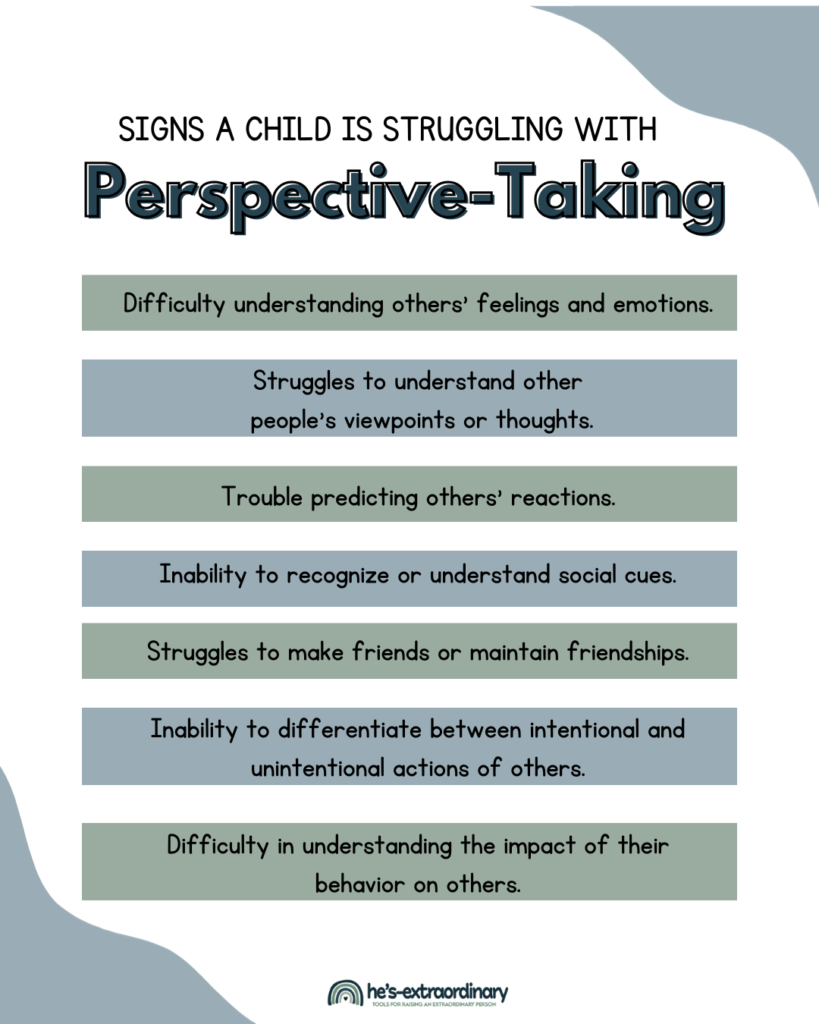
Teaching Strategies for Building Perspective-Taking
There are a variety of effective teaching strategies for building social skills, such as perspective-taking.
It’s important to tailor teaching strategies to children’s unique developmental needs and learning styles.
Some popular educational tools and techniques include:
- Visual supports
- Role-Play scenarios
- Breaking down and simplifying social interactions so they’re more easily understood
- Explicit teaching
- Children’s books/storytelling
- Reflective discussions
- Technology and multimedia
- Visual arts
- Peer interactions
- Implementing a structured, predictable environment
Apps & Online Resources for Perspective-Taking:
Apps and online resources offer an interactive and engaging way to make learning about social skills like perspective-taking more relatable and accessible for kids.
These digital tools often use gamified elements, making learning enjoyable and motivating. Plus, they provide consistent, on-demand opportunities for practice, allowing children to revisit and hone their skills at their own pace.
- Avokiddo Emotions: Interactive app allows children to play with virtual characters, understanding their varied emotions.
- Quandary: A game-based learning platform where kids solve dilemmas, emphasizing ethical decision-making.
- Daniel Tiger’s Neighborhood: Play at Home with Daniel: An app based on the popular TV show, teaches kids about emotions and routines.
- Touch and Learn – Emotions: Helps kids match emotions to facial expressions and situations, enhancing their empathy.
- Smiling Mind: Developed by psychologists and educators, this app offers age-specific mindfulness activities that can enhance emotional awareness and perspective-taking. This is an all-ages app with tools for adults, too!
- Peppy Pals: A series of games and interactive stories that emphasize emotions, empathy, and friendship without using any text or language.
Visual Arts Activities for Building Perspective-Taking:
“Picture Their World” Painting:
- How to do it: Ask children to paint a scene from the perspective of someone/something (like a friend, family member, a pet, or even an ant). Encourage them to think about what that individual sees, feels, and experiences.
- Benefits: Helps kids understand the everyday experiences of those around them.
“Emotion Masks” Craft:
- How to do it: Provide children with plain masks and art supplies. Have them design masks that represent different emotions.
- Benefits: Helps children visually express and recognize a range of emotions, a necessary aspect of building empathy.
“Walk in My Shoes” Activity:
How to do it:
- Use the free printable here.
- Assign or allow kids to choose a person to complete this activity about. It could be a partner or friend in class, someone from a different culture, a character in a book you just read or a movie you just watched. The possibilities are endless.
- Then, using pictures they find online or cutting and pasting from old magazines, or by drawing pictures, fill the shoes with photos, symbols, or colors representing the life of the shoe’s wearer.
- Benefits: Encourages kids to think about how different people have different life experiences, routines, likes, and dislikes.
“Through Their Eyes” Photography Project:
- How to do it: With a camera or smartphone, children capture moments from the viewpoint of someone else (e.g., a toddler, an elderly person, or someone from another culture). Have them create a photo album to showcase their photographs.
- Benefits: Offers a literal lens into seeing the world from another’s perspective.
Board Games That Enhance Perspective-Taking Skills:
- Guess Who?: Players deduce their opponent’s chosen character by asking yes-or-no questions, requiring them to think from another’s viewpoint.
- Pandemic: A cooperative game where players must strategize together to stop global outbreaks, emphasizing the need to consider and combine different players’ viewpoints.
- Dixit: Players provide abstract clues for image cards and must think about how others might interpret the images differently. This game also has tons of expansion packs.
- The Resistance: A game of social deduction where players try to figure out who amongst them are traitors, requiring keen observation and understanding of other players’ actions and motives.
- Clue (or Cluedo): Players must determine the game’s mystery using deduction, trying to think about what other players might know based on their actions.
- Sheriff of Nottingham: Players take turns being the sheriff, deciding which merchants are telling the truth. It challenges players to read and predict their opponents’ intentions.
Interactive Games That Build Perspective-Taking Skills:
- Charades: Players act out a word or phrase without speaking, requiring guessers to interpret the actor’s perspective to deduce the answer.
- 20 Questions: One player thinks of an item, and others ask up to 20 questions to determine what it is, forcing them to think from the perspective of the first player.
- Would You Rather: Players are presented with two options and must choose one, offering insights into individual preferences and values. Download 115 free “would you rather” questions for kids here.
- Two Truths and a Lie: Players state two true things and one false thing about themselves, challenging others to determine which statement is untrue by considering the player’s perspective.
Printable Worksheets to Build Perspective-Taking Skills
Printable worksheets are structured tools that guide kids in practicing and refining new skills. These printable perspective-taking worksheets encourage kids to place themselves in another person’s shoes, understand how others think, and compare similarities and differences between their thinking and others.
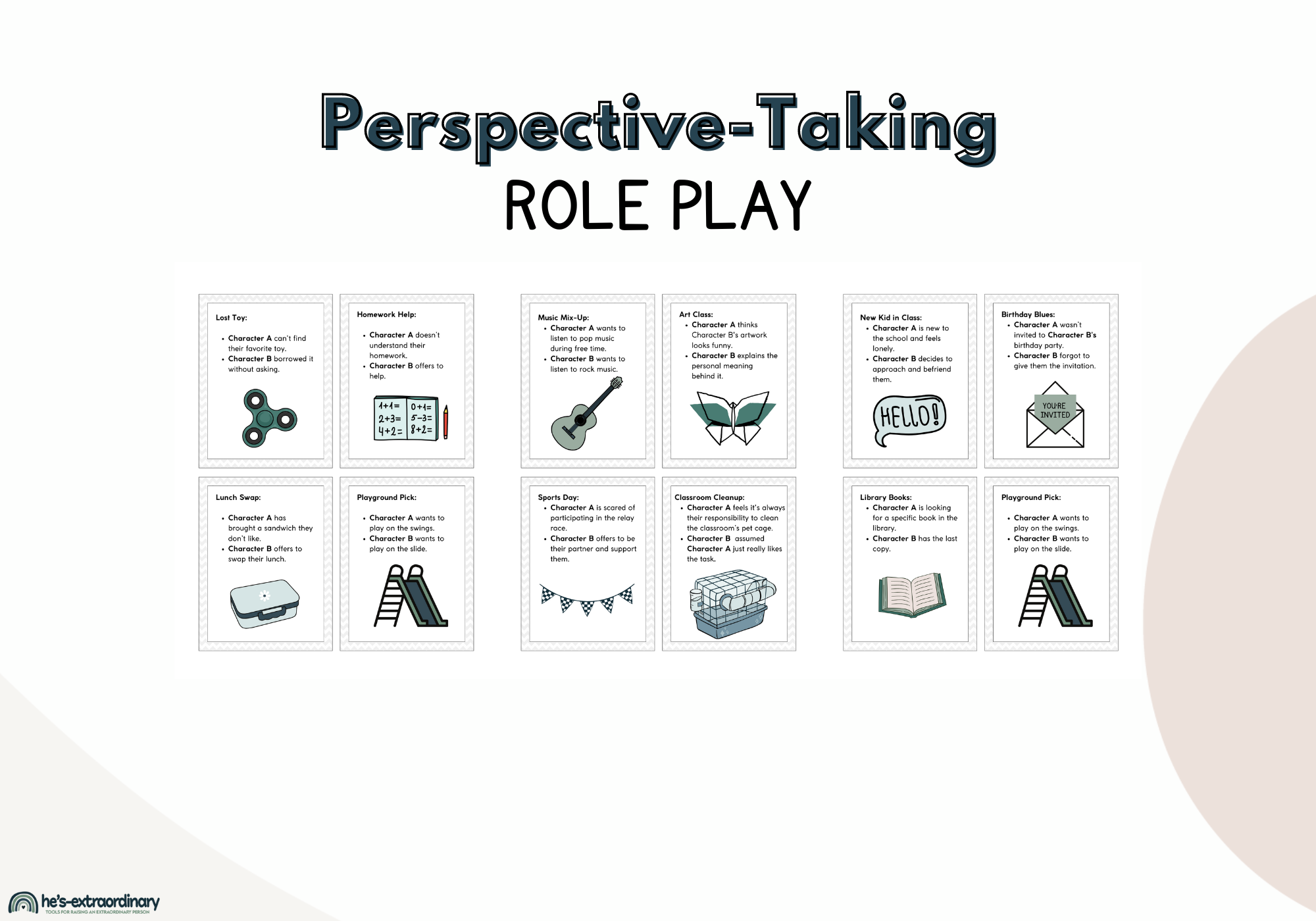
Perspective-Taking Role-Play Cards
12 role-play scenario cards. Kids work in partners, taking turns role-playing the situation in each role and then discuss the different thoughts, feelings, and reasons behind their actions.
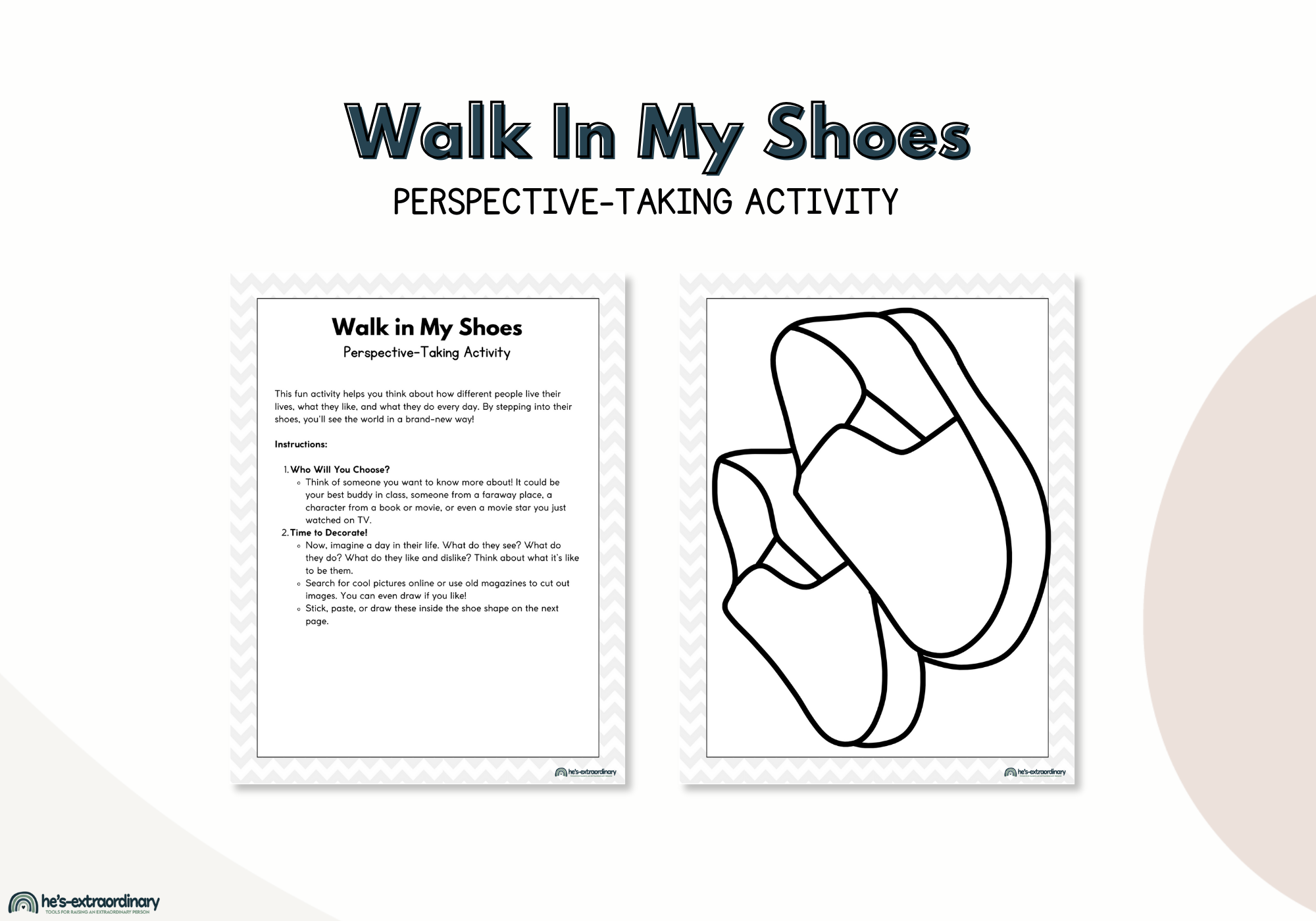
Walk In My Shoes – Perspective Taking Activity
Kids use pictures they find online, cut and paste from old magazines, or draw to fill the shoes with photos, symbols, or colors representing the life of the shoe’s wearer. Encourages kids to think about how different people have different life experiences, routines, likes, and dislikes.
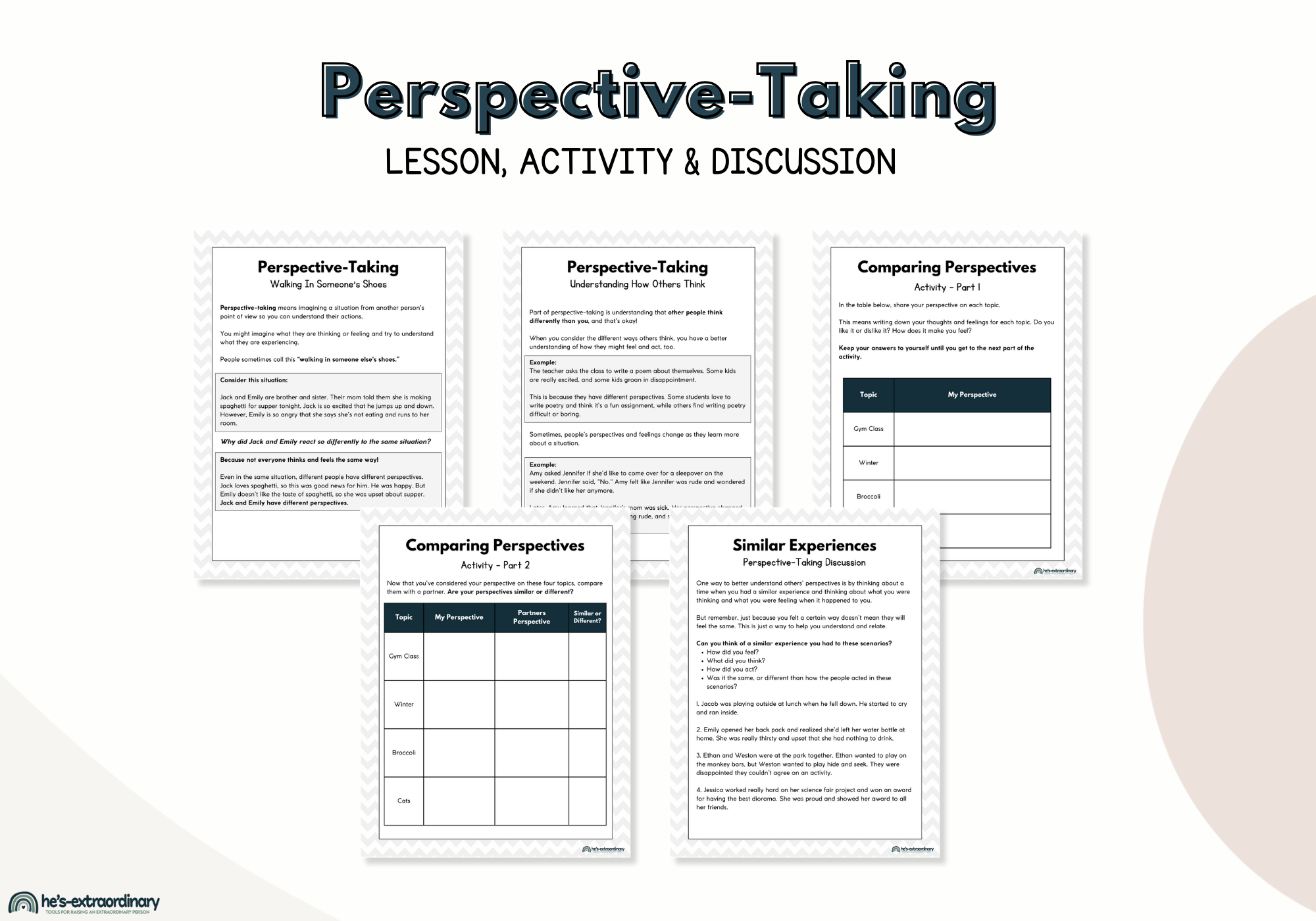
Perspective-Taking Lesson, Activity, and Discussion
Five-page perspective-taking lesson that covers walking in someone else’s shoes, understanding how others think, a two-part activity on comparing perspectives, and four discussion questions about sharing similar experiences with others.
Using a mixture of traditional teaching practices, activities, board games, visual arts, and digital tools creates a variety of experiences for children to cultivate their perspective-taking skills.
